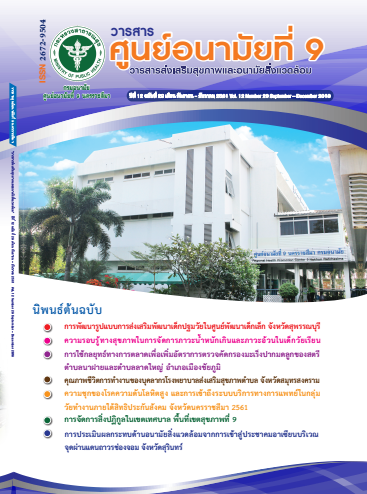ความรอบรู้ทางสุขภาพในการจัดการภาวะน้ำหนักเกินและภาวะอ้วนในเด็กวัยเรียน
คำสำคัญ:
ภาวะน้ำหนักเกิน, ภาวะอ้วน, เด็กวัยเรียน, ความรอบรู้ทางสุขภาพบทคัดย่อ
ภาวะน้ำหนักเกินและภาวะอ้วนในเด็กมีแนวโน้มเพิ่มขึ้นเรื่อยๆทั่วโลก ในประเทศไทยเด็กวัยเรียนเป็นกลุ่มที่มีมีอุบัติการณ์และความชุกของภาวะน้ำหนักเกินและภาวะอ้วนเพิ่มขึ้นอย่างรวดเร็วมากที่สุด เนื่องจากเป็นช่วงวัยของการเจริญเติบโตและพัฒนาการในทุกๆด้าน ความรอบรู้ทางสุขภาพในการจัดการกับภาวะน้ำหนักเกินและภาวะอ้วน จึงเป็นส่วนสำคัญนำไปสู่ความสำเร็จ การศึกษาความรอบรู้ทางสุขภาพในการจัดการภาวะน้ำหนักเกินและภาวะอ้วนของตัวเด็ก ผู้ปกครอง คุณครู และเพื่อนสนิท ในพื้นที่เขตสุขภาพที่4 จังหวัดสระบุรี พบว่า เด็กวัยเรียนที่มีภาวะน้ำหนักเกินและภาวะอ้วนจำนวน 360 คนเข้าร่วมการวิจัย ร้อยละ 80 มีภาวะน้ำหนักเกิน และร้อยละ 20 มีภาวะอ้วน พบเด็กวัยเรียนที่มีภาวะน้ำหนักเกินและภาวะอ้วนมีความรอบรู้ทางสุขภาพในการจัดการภาวะน้ำหนักเกินและภาวะอ้วนระดับกลางและรู้ว่าตนเองไม่รู้อะไร อย่างมีนัยสำคัญทางสถิติ (p< 0.05) ในด้านการรับรู้และความตระหนักพบว่าเด็กที่มีภาวะอ้วนมีความรับรู้และตระหนักว่าตัวเองอ้วนมากกว่าเด็กที่มีภาวะน้ำหนักเกินความสัมพันธ์อย่างมีนัยสำคัญทางสถิติ (p< 0.05) ซึ่งสามารถนำไปสู่การสร้างโปรแกรมควบคุมน้ำหนักและปรับเปลี่ยนพฤติกรรมให้สามารถลดความอ้วนในเด็กวัยเรียนแบบมีส่วนร่วมได้อย่างมีประสิทธิผลและมีประสิทธิภาพภาพ ลดการเกิดภาวะน้ำหนักเกินและภาวะอ้วนในอนาคต
References
2. Centers for Disease Control and Prevention. Overweight & Obesity: Defining Childhood Obesity. [cited 2016 Oct 20]. from https://www.cdc.gov/obesity/childhood/defining.html.
3. Centers for Disease Control and Prevention. Healthy Weight: About Child & Teen BMI. [cited 2018 Oct 24]. from https://www.cdc.gov/healthyweight/assessing/bmi/childrens_bmi/about_childrens_bmi.html.
4. Institute of Medical Research and Technology Assessment, Ministry of Public Health. Clinical practice guild line of preventing and caring obesity.2010: Bangkok.
5. NCD Risk Factor Collaboration (NCD-RisC). Worldwide trends in body-mass index, underweight, overweight, and obesity from 1975 to 2016: a pooled analysis of 2416 population-based measurement studies in 128·9 million children, adolescents, and adults. Lancet. 2017 Dec 16;390(10113):2627-2642.
6. World Health Organization. Global Strategy on Diet, Physical Activity and Health: Childhood overweight and obesity. [ND]. from http://www.who.int/dietphysicalactivity/childhood/en/.
7. World Health Organization. Obesity and overweight : Key facts. [ND]. from http://www.who.int/mediacentre/factsheets/fs311/en/.
8. สาธารณสุข, กระทรวง. รายงานตามตัวชี้วัดในระดับกระทรวง ปี 2562: ร้อยละของเด็กวัยเรียน สูงดี สมส่วน ปีงบประมาณ 2562. จากเว็บไซต์: https://hdcservice.moph.go.th/hdc/reports/report_kpi.php?flag_kpi_level=1&flag_kpi_year=2019&source=pformated/format1.php&id=e28682b2718e6cc82b8dbb3e00f2e28e.
9. กระทรวงสาธารณสุข.ยุทธศาสตร์ ตัวชี้วัด และแนวทางการจัดเก็บข้อมูล กระทรวงสาธารณสุข ปีงบประมาณ พ.ศ. 2559, หน้า 5.
10. Rimm AA, Hartz AJ, Fischer ME. A weight shape index for assessing risk of disease. C Clin Epidemiol 1988; 41 (5):458-65.
11. Berkowitz RI. Obesity in childhood and adolescence .In: Walker WA, Watkins JB, editors. Nutrition in Pediatrics. Basic science and clinical applications. London:BC Decker inc; 1997. p. 716-23.
12. Harsha DW, Bray GA. Body composition and childhood obesity. Endocr Metab Clin 1996; 25:871-85.
13. Alemzadeh R, Lifshitz F. Childhood obesity.In: Lifhitz F, editor. Pediatric endocrinology. New York: Marcel Deccer, Inc; 1996. h. 753-74.
14. Greydanus DE , Agana M, Kamboj MK, Shebrain S, Soares N, Eke R, Patel DR. Pediatric obesity: Current concepts. Dis Mon. 2018 Jan 9. pii: S0011-5029(17)30192-X.
15. Kumar S, Kelly AS. Review of Childhood Obesity: From Epidemiology, Etiology, and Comorbidities to Clinical Assessment and Treatment. Mayo Clin Proc. 2017 Feb;92(2):251-265.
16. Bhat ZF, Morton JD, Mason S, Bekhit AEA, Bhat HF. Obesity and neurological disorders: Dietary perspective of a global menace. Crit Rev Food Sci Nutr. 2017 Dec 19:1-17.
17. Martin A, Saunders DH, Shenkin SD, Sproule J. Lifestyle intervention for improving school achievement in overweight or obese children and adolescents. Cochrane Database Syst Rev. 2014 Mar 14; (3).
18. O'Brien PD, Hinder LM, Callaghan BC, Feldman EL. Neurological consequences of obesity. Lancet Neurol. 2017 Jun; 16(6).
19. O'Brien SH, Holubkov R, Reis EC. Identification, evaluation, and management of obesity in an academic primary care center. Pediatrics. 2004 Aug; 114(2):e154-9.
20. Mendez R, Grissom M. Disorders of childhood growth and development: childhood obesity. FP Essent. 2013 Jul; 410:20-4.
21. Warden NA, Warden CH. Biological influences on obesity. Pediatr Clin North Am2001; 48:879-91.
22. Mo-suwan L, Geater AF. Risk factors for childhood obesity in a transitional society in Thailand. Int J Obes Relat Metab Disord1996; 20:697-703.
23. Monteiro PO, Victora CG. Rapid growth in infancy and childhood and obesity in later life--a systematic review. Obes Rev2005; 6:143-54.
24. Arenz S, Ruckerl R, Koletzko B, von Kries R. Breast-feeding and childhood obesity--a systematic review. Int J Obes Relat Metab Disord2004; 28:1247-56.
25. Dubois L, Girard M. Early determinants of overweight at 4.5 years in a population-based longitudinal study. Int J Obes (Lond) 2006; 30:610-7.
26. Galvez MP, Hong L, Choi E, Liao L, Godbold J, Brenner B. Childhood obesity and neighborhood food-store availability in an inner-city community. Acad Pediatr2009; 9:339-43.
27. กรมอนามัย.ประเด็น ความรอบรู้ด้านสุขภาพ.เอกสารประกอบการจัดทำแผนการปฏิรูปประเทศด้านสาธารณสุข. http://dohhl.anamai.moph.go.th/ewt_dl_link.php?nid=57.
28. Kutner, M., Greenberg, E., Jin, Y., & Paulsen, C.. The health literacy of America’s adults: Results from the 2003 National Assessment of Adult Literacy (NCES 2006-483). Washington, DC: U.S. Department of Education, National Center for Education Statistics. 2006.
29. Kirsch, I. S., Jungeblut, A., Jenkins, L., & Kolstad, A. Adult literacy in America: A first look at the findings of the National Adult Literacy Survey (NCES 93275). Washington, DC: U.S. Department of Education.. 1993.
30. Anne McCarthy and Jennifer Lynch. National Health Literacy Policy and Strategy, Research Report NALA. 2002.
31. Pelikan J., Röthlin F., Ganahl K., on behalf of the hls-eu consortium. Comparative report on health literacy in eight EU member states (The European Health literacy Project HLS‐EU 2009‐2012). Wien, 2012.
32. Dutch Health Literacy Alliance. [Online]. [cited 2017 November 19. Available from: http://www.gezondheidsvaardigheden.nl/english.
33. Lawrence T Lamand Li Yang.Archives of Public HealthThe official journal of the Belgian Public Health Association201472:11.https://doi.org/10.1186/2049-3258-72-11.
34. Berkman ND, Sheridan SL, Donahue KE, Halpan DJ, Crothy K: Low health literacy and health outcomes: an updated systematic review. Ann Intern Med 2011, 155:97–107.
35. Bishwalata R, Singh AB, Singh AJ, Devi LU, Singh RK: Overweight and obesity among schoolchildren in Manipur, India. Natl Med J India 2010,23: 263–266.
36. Sharif I, Blank AE: Relationship between child health literacy and body mass index on overweight children. Patient Educ Counsel 2010, 79:43–48.
37. Tremblay MS, Willms JD. Is the Canadian childhood obesity epidemic related to physical inactivity? Int J Obes Relat Metab Disord2003;27 :1100-5.
Downloads
เผยแพร่แล้ว
How to Cite
ฉบับ
บท
License
บทความหรือข้อคิดเห็นใด ๆ ที่ประกฎในวารสารศูนย์อนามัยที่ 9 เป็นความคิดเห็นของผู้เขียน บรรณาธิการ คณะผู้จัดทำ และศูนย์อนามัยที่ 9 นครราชสีมา (เจ้าของ) ไม่จำเป็นต้องเห็นด้วย ผู้เขียนต้องรับผิดชอบต่อบทความของตนเอง
ผลการพิจารณาของกองบรรณาธิการและผู้ทรงคุณวุฒิถือเป็นที่สิ้นสุด คณะบรรณาธิการวารสารฯ ขอสงวนสิทธิ์ในการตรวจแก้ไขข้อความให้ถูกต้องตามหลักภาษาและมีความเหมาะสม
กองบรรณาธิการวารสารฯ ขอสงวนสิทธิ์มิให้นำเนื้อหาใด ๆ ของบทความ หรือข้อคิดเห็นใด ๆ ของผลการประเมินบทความในวารสารฯ ไปเผยแพร่ก่อนได้รับอนุญาตจากกองบรรณาธิการ อย่างเป็นลายลักษณ์อักษร และผลงานที่ได้รับการตีพิมพ์ถือเป็นลิขสิทธิ์ของวารสารศูนย์อนามัยที่ 9

